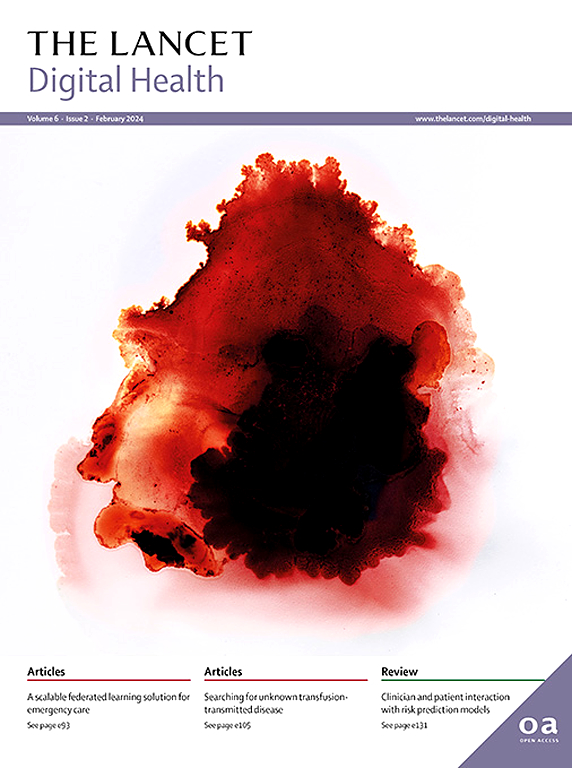人工智能辅助鼻咽癌内镜图像检测:一项全国性、多中心、模型开发和验证研究。
IF 23.8
1区 医学
Q1 MEDICAL INFORMATICS
引用次数: 0
摘要
背景:鼻咽癌早期诊断治愈率高。然而,鼻咽部解剖位置模糊,局部影像学表现与其他鼻咽部疾病相似,往往导致诊断困难,导致延误或漏诊。我们的目标是开发一种深度学习算法,通过在内窥镜检查中区分鼻咽癌、良性增生和正常鼻咽来提高耳鼻喉科医生的诊断能力。方法:在这项全国性、多中心的模型开发和验证研究中,我们开发了一种基于Swin变压器的鼻咽癌诊断(STND)系统,用于识别鼻咽癌、良性增生和正常鼻咽癌。STND采用来自8个著名鼻咽癌中心(1期)的27 362张鼻咽内镜图像(10 693张活检证实的鼻咽癌,7073张活检证实的良性增生,9596张正常鼻咽癌),并通过来自10家鼻咽癌高发综合医院(2期)的1885张前瞻性图像进行外部验证。此外,我们进行了一项完全交叉、多读者、多病例的研究,涉及来自四个地区领先的鼻咽癌中心的四名专家耳鼻喉科医生,以及来自24个地理位置不同的初级医院的24名普通耳鼻喉科医生。该研究包括400张图像,以评估专家和普通耳鼻喉科医生在使用和不使用STND系统的情况下在现实环境中的诊断能力。结果:内部研究(2017年1月1日至2023年1月31日)使用的内镜图像来自15 521人(男性9033人[58.2%],女性6488人[41.8%];平均年龄47.6岁[IQR 38.4 ~ 56.8])。来自945名参与者的图像(男性538人[56.9%],女性407人[43.1%];平均年龄45·2岁[IQR 35.2 - 55.2])进行外部验证。内部数据集中的STND以曲线下面积(AUC)为0.99 (95% CI为0.99 ~ 0.99)区分正常鼻咽图像与异常(良性增生和鼻咽癌),以AUC为0.99 (95% CI为0.98 ~ 0.99)区分恶性图像(即鼻咽癌)与非恶性图像(即良性增生和正常鼻咽)。在外部验证中,该系统检测鼻咽癌的AUC为0.95 (95% CI为0.94 ~ 0.96),灵敏度为91.6% (95% CI为89.3 ~ 93.5),特异性为86.1% (95% CI为84.1 ~ 89.7)。在多读者、多病例研究中,人工智能(AI)辅助策略使耳鼻喉科医生的诊断准确性提高了7.9%,从83.4% (95% CI 801 - 86.7,无AI辅助)增加到91.2% (95% CI 88.6 - 99.3,有AI辅助);解释:我们的深度学习系统在鼻咽癌的内镜图像诊断方面显示出了巨大的临床应用潜力。该系统为基层医院的采用提供了实质性的好处,旨在提高特异性,避免额外的活检,并减少漏诊。资助项目:颅底肿瘤内窥镜手术新技术:CAMS医学科学创新基金;上海市科学技术委员会基金;上海市临床重点专科;国家临床重点专科;以及青年精英科学家资助计划。本文章由计算机程序翻译,如有差异,请以英文原文为准。
Artificial intelligence-assisted detection of nasopharyngeal carcinoma on endoscopic images: a national, multicentre, model development and validation study
Background
Nasopharyngeal carcinoma is highly curable when diagnosed early. However, the nasopharynx’s obscure anatomical position and the similarity of local imaging manifestations with those of other nasopharyngeal diseases often lead to diagnostic challenges, resulting in delayed or missed diagnoses. Our aim was to develop a deep learning algorithm to enhance an otolaryngologist’s diagnostic capabilities by differentiating between nasopharyngeal carcinoma, benign hyperplasia, and normal nasopharynx during endoscopic examination.
Methods
In this national, multicentre, model development and validation study, we developed a Swin Transformer-based Nasopharyngeal Diagnostic (STND) system to identify nasopharyngeal carcinoma, benign hyperplasia, and normal nasopharynx. STND was developed with 27 362 nasopharyngeal endoscopic images (10 693 biopsy-proven nasopharyngeal carcinoma, 7073 biopsy-proven benign hyperplasia, and 9596 normal nasopharynx) sourced from eight prominent nasopharyngeal carcinoma centres (stage 1), and externally validated with 1885 prospectively acquired images from ten comprehensive hospitals with a high incidence of nasopharyngeal carcinoma (stage 2). Furthermore, we did a fully crossed, multireader, multicase study involving four expert otolaryngologists from four regional leading nasopharyngeal carcinoma centres, and 24 general otolaryngologists from 24 geographically diverse primary hospitals. This study included 400 images to evaluate the diagnostic capabilities of the experts and general otolaryngologists both with and without the aid of the STND system in a real-world environment.
Findings
Endoscopic images used in the internal study (Jan 1, 2017, to Jan 31, 2023) were from 15 521 individuals (9033 [58·2%] men and 6488 [41·8%] women; mean age 47·6 years [IQR 38·4–56·8]). Images from 945 participants (538 [56·9%] men and 407 [43·1%] women; mean age 45·2 years [IQR 35·2– 55·2]) were used in the external validation. STND in the internal dataset discriminated normal nasopharynx images from abnormalities (benign hyperplasia and nasopharyngeal carcinoma) with an area under the curve (AUC) of 0·99 (95% CI 0·99–0·99) and malignant images (ie, nasopharyngeal carcinoma) from non-malignant images (ie, benign hyperplasia and normal nasopharynx) with an AUC of 0·99 (95% CI 0·98–0·99). In the external validation, the system had an AUC for the detection of nasopharyngeal carcinoma of 0·95 (95% CI 0·94–0·96), a sensitivity of 91·6% (95% CI 89·3–93·5), and a specificity of 86·1% (95% CI 84·1–87·9). In the multireader, multicase study, the artificial intelligence (AI)-assisted strategy enhanced otolaryngologists’ diagnostic accuracy by 7·9%, increasing from 83·4% (95% CI 80·1–86·7, without AI assistance) to 91·2% (95% CI 88·6–93·9, with AI assistance; p<0·0001) for primary care otolaryngologists. Reading time per image decreased with the aid of the AI model (mean 5·0 s [SD 2·5] vs 6·7 s [6·0] without the model; p=0·034).
Interpretation
Our deep learning system has shown significant clinical potential for the practical application of nasopharyngeal carcinoma diagnosis through endoscopic images in real-world settings. The system offers substantial benefits for adoption in primary hospitals, aiming to enhance specificity, avoid additional biopsies, and reduce missed diagnoses.
Funding
New Technologies of Endoscopic Surgery in Skull Base Tumor: CAMS Innovation Fund for Medical Science; Shanghai Science and Technology Committee Foundation; Shanghai Municipal Key Clinical Specialty; National Key Clinical Specialty Program; and the Young Elite Scientists Sponsorship Program.
求助全文
通过发布文献求助,成功后即可免费获取论文全文。
去求助
来源期刊

Lancet Digital Health
Multiple-
CiteScore
41.20
自引率
1.60%
发文量
232
审稿时长
13 weeks
期刊介绍:
The Lancet Digital Health publishes important, innovative, and practice-changing research on any topic connected with digital technology in clinical medicine, public health, and global health.
The journal’s open access content crosses subject boundaries, building bridges between health professionals and researchers.By bringing together the most important advances in this multidisciplinary field,The Lancet Digital Health is the most prominent publishing venue in digital health.
We publish a range of content types including Articles,Review, Comment, and Correspondence, contributing to promoting digital technologies in health practice worldwide.
 求助内容:
求助内容: 应助结果提醒方式:
应助结果提醒方式:


